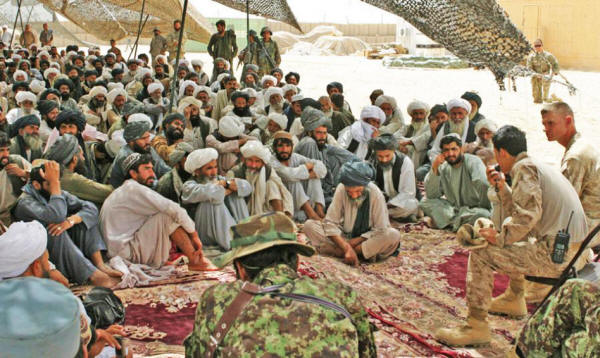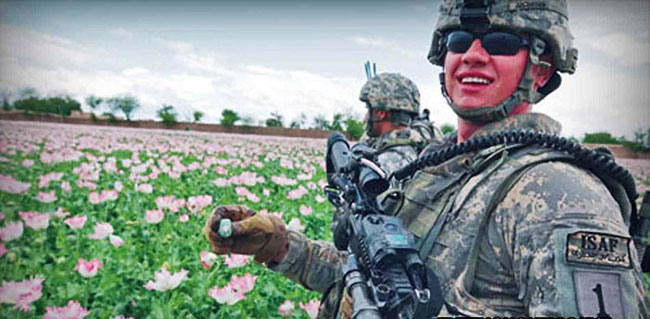|
$1.5 million a day into Afghanistan to fight heroin production and in that time, heroin production has more than quadrupled...
On November 5 yet another U.S. soldier was killed by a member of Afghanistan's military forces, as the country continues to be wracked by violence in its seventeenth year of war.
Donald Rumsfeld was U.S. Secretary for Defence from 2001 to 2006 under President George W. Bush.
They, along with other psychotic figures such as Vice-President Dick Cheney, were responsible for the invasions of Afghanistan and Iraq, and their legacy is apparent in many spheres, one of which is the drug production bonanza in Afghanistan.
In August 2004 NBC News reported Secretary Rumsfeld as declaring,
He issued the warning that,
Rumsfeld, for once during his catastrophic years as chief war-maker, was absolutely right, and his pronouncement about likely danger and impending corruption was spot on.
The U.S. invasion and subsequent operations led to Afghanistan becoming the fourth most dangerous and fourth most corrupt country in the world.
The "drug problem" to which he referred has expanded rapidly over the years. It is destroying Afghanistan. It is a main reason for the place being ungovernable.
It's all very well to blame Afghans for growing poppies and producing opium and heroin, but what they are doing is meeting international demand.
After all, there would be no drug industry in Afghanistan if there wasn't a welcoming market in the drug-loving prosperous West - although it has to be noted that only about four per cent of its massive narcotics production ends up in the U.S., which gets most of its heroin from South America.
Mr. John Sopko, the U.S. Special Inspector General for Afghan Reconstruction (SIGAR), has just produced his latest quarterly report for the U.S. Congress in which he observes that,
Mr. Sopko observed that efforts to combat drugs,
...and the increase in the area and quantity of poppy cultivation has been impressive and depressing.
Washington is well aware of the shattering effects of Afghan drug production, but the SIGAR writes that,
It is amazing that,
What happened to the campaign against drug processing that began in November 2017 when,
The massive aerial bombardment of ten drug-processing laboratories included strikes by some Afghan air force Tucano aircraft, but the main assault was by the U.S. Air Force which for the first time in Afghanistan used,
This was a major - and very expensive - operation.
The commander of foreign forces in Afghanistan, U.S. General John Nicholson, told a news conference,
Not only that, but,
He said,
So after that first attack in November 2017 there were ten down and about 400 to go.
But SIGAR tells us in October 2018 that,
Why?
There is nobody better placed to explain this than Mr Sopko, who had already observed that the Pentagon's airstrike campaign against drug laboratories might not have the intended effect, as its,
Not only this, but,
He was right on the button, because, as reported by The Washington Post, in January to June 2018 the UN Assistance Mission in Afghanistan,
There is no doubt that these casualties alienate the rural population, given the example of one strike in July 2018 when the New York Times wrote that,
Time after time the U.S.-NATO and Afghan authorities "initially deny" that there have been civilian deaths or casualties caused by airstrikes and are then found to be disguising the truth because there can be no denial of facts when shrapnel-ridden bodies of little children are laid out on the ground.
Such absurd statements play right into the hands of the militants and, in the predictive words of the SIGAR, "strengthen the insurgency." This might explain why the massive and much-publicized air campaign against opium-processing facilities has been abandoned.
But what happens now?
The U.S. State Department and the Pentagon were told by experts that the narcotics problem was immense.
For example, in a speech at Georgetown University in 2014 the SIGAR said:
Nothing has changed since then.
The 2017 aerial blitz failed utterly, as have so many plans and operations to attempt to reduce narcotics production, and the U.S.-NATO military alliance in Afghanistan continues to flounder in a quagmire of insurgency.
The drug catastrophe is plain for all to see, and after seventeen years of war and expenditure of eight billion dollars the illegal narcotics industry is thriving...
|



